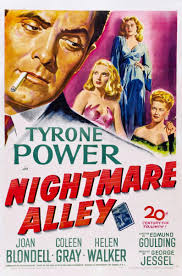Nightmare Alley gazes at the underbelly of show business. It tells the story of a small-time hustler, Stanton "Stan" Carlisle (Tyrone Power) who begins the movie as a worker at a travelling carnival and rises to fame and fortune as a mentalist doing cold readings before falling spectacularly, undone by his greed, wandering eye, and arrogance. It's a morality play crossed with a tragedy.
“The spook racket,” Stan declares, “I was made for it.” In many ways, he's a perfect showman: handsome, dapper, well spoken, quick on his feet, and never at a loss for words.
He's a con artist; he looks at the paying public not as customers but as marks and rubes to take advantage of. Everywhere he goes, he looks for angles to exploit and plays off people's emotions, not just the woman whose dead daughter he says he communicates with but also the people who help and love him.
The movie takes us behind the curtain of show business, shows us the inner workings. We see the hidden compartments and the sleight of hands that make the magic acts appear genuine, and so does Stan.
He learns from Zeena (Joan Blondell), the fortune teller, about the code she and her husband Pete (Ian Keith) used when they were at the top to make it seem she could read minds and see the future. Certain words and enunciations tip her off. Now, Pete's a drunk, but Zeena keeps the code as their "nest egg." There's also Molly (Coleen Gray). Stan flirts with her, and she reciprocates, even though she lives with Bruno the strongman (Mike Mazurki).
Carnivals are considered lowbrow, seedy attractions, but Nightmare Alley shows there's not much difference between fleecing rubes in small towns and conning the high society types in Chicago clubs. Once he learns Zeena's code, Stan moves up in the world, going from outdoor shows on cramped, rundown stages to wearing formal wear as the "Great Stanton," entertaining the rich and prominent. He goes from raking in a few bucks at a time to extracting thousands from those he convinces of his "gift."
Visually, Nightmare Alley has the expected hallmarks of film noir: the black-and-white photography, the extensive use of shadows, the harsh lighting, and distorted closeups. Instead of one femme fatale, we get three to varying degrees: Zeena, who introduces Stan to the con of mentalism; Molly, who goes along with his schemes; and Lilith Ritter (Helen Walker), a psychoanalyst who records sessions with her patients, which gives her and Stan an interesting if repugnant business idea.
While Zeena and Molly might not be all bad, all three women play a part in leading Stan to his downfall. The difference is while he deceives the carnival women, it's Lilith who tricks him.
The film leads to an incredibly dark, almost perfect ending before a disappointing last-second change of heart suggests there might be some hope for Stan. It's a false note in an otherwise fine example of the genre. There's no hope in film noir. Only despair and damnation.




No comments:
Post a Comment